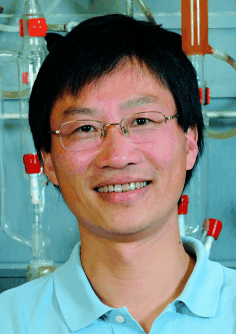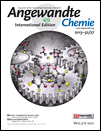Author Profile
Jieping Zhu
First published: 05 February 2013
Graphical Abstract
References
- 1“SNAr-Based Macrocyclization: An Application to the Synthesis of Vancomycin Family Models”: R. Beugelmans, G. P. Singh, M. Bois-Choussy, J. Chastanet, J. Zhu, J. Org. Chem. 1994, 59, 5535–5542. This paper deals with the use of intramolecular SNAr reaction for the synthesis of strained cyclophanes that have an endo aryl–aryl ether bond. This cycloetherification method, initially aimed at solving the vancomycin synthesis problem, has since been used by many groups, academic and industrial alike, as a key step in the synthesis of different classes of natural products and medicinally relevant compounds.
- 2“A Five-Component Synthesis of Hexasubstituted Benzene”: P. Janvier, H. Bienaymé, J. Zhu, Angew. Chem. 2002, 114, 4467–4470;
10.1002/1521-3757(20021115)114:22<4467::AID-ANGE4467>3.0.CO;2-O Google ScholarAngew. Chem. Int. Ed. 2002, 41, 4291–4294. We were working on the concept of “substrate design” for the development of novel multicomponent reactions. This paper illustrates nicely the potential of such an approach in the synthesis of complex druglike heterocycles. In this five-component reaction, seven functional groups were involved in a sequence of nine elementary reactions leading to the creation of a hexasubstituted benzene ring with the formation of seven chemical bonds (5 CC and 2 CN bonds). Heating a toluene solution of readily available starting materials in the presence of a catalytic amount of camphorsulfonic acid is all that was needed to trigger this mechanistically complex process.10.1002/1521-3773(20021115)41:22<4291::AID-ANIE4291>3.0.CO;2-D CAS PubMed Web of Science® Google Scholar
- 3“Total Synthesis of Ecteinascidin 743”: J. Chen, X. Chen, M. Bois-Choussy, J. Zhu, J. Am. Chem. Soc. 2006, 128, 87–89. Ecteinascidin 743 (Et 743), a marine natural product with a complex molecular structure, displays potent antitumor activities and has been commercialized as an anticancer drug since 2007 (Yondelis and Trabectedin). Like taxol, this alkaloid is yet another showcase of the importance of organic chemistry, as laboratory synthesis is the only means to date to solve the supply problem. This paper describes a convergent and efficient total synthesis that is scalable and amenable to the synthesis of analogues. Importantly, the chemistry we learnt during this exercise allowed us to develop original synthetic routes to several other polycyclic tetrahydroisoquinoline-containing alkaloids.
- 4“Brønsted Acid Catalyzed Enantioselective Three-Component Reaction Involving α Addition of Isocyanides to Imines”: T. Yue, M.-X. Wang, D.-X. Wang, G. Masson, J. Zhu, Angew. Chem. 2009, 121, 6845–6849; Angew. Chem. Int. Ed. 2009, 48, 6717–6721. The Ugi four-component reaction is without doubt one of the most important multicomponent reactions. Initially developed for the synthesis of peptidelike structures, it has now been extended to a huge variety of heterocycles. The downside of this reaction is the difficulty encountered to control the absolute configuration of the newly generated stereogenic center. In collaboration with the group of Prof. M.-X. Wang (Tshinghua University), we presented the first catalytic enantioselective Ugi-type reaction leading to enantioenriched 2-aminoalkyl-5-aminooxazoles. Enantioselective addition of isocyanide to imine remains an unsolved problem, the results reported in this paper provided nevertheless an optimistic view regarding the future development of this powerful reaction.
- 5“Palladium(II)-Catalyzed Intramolecular Diamination of Alkynes under Aerobic Oxidative Conditions: Catalytic Turnover of an Iodide Ion”: B. Yao, Q. Wang, J. Zhu, Angew Chem. 2012, 124, 5260–5264; Angew Chem. Int. Ed. 2012, 51, 5170–5174. Pd0-catalyzed cyclization of ortho-alkynylanilines is a powerful method for the synthesis of 2,3-disubstituted indoles. Fundamentally, it consists of adding one nucleophile and one electrophile across the triple bond. We showed in this paper that Pd(OAc)2 , under oxidative conditions, could initiate a domino process that allow the introduction of two nucleophiles across the triple bond. The results of ongoing research clearly indicated that, in addition to amides, other carbon nucleophiles could enter into this catalytic process, leading to diversely functionalized indoles. We are looking forward to further exploiting the reaction scope and understanding the reaction mechanism.





